Rule 18: The “Buoy-Room” Rule
by David Dellenbaugh
Rule 18, which takes up more than two pages, is the longest rule in the rulebook. It may also be the most complex, considering that it’s the subject of more than two dozen ISAF Cases alone.
Rule 18 is commonly called the “buoy room” rule, but its real title is “Rounding
and Passing Marks and Obstructions.” It applies almost every time you round a
mark, and also when you pass obstructions.
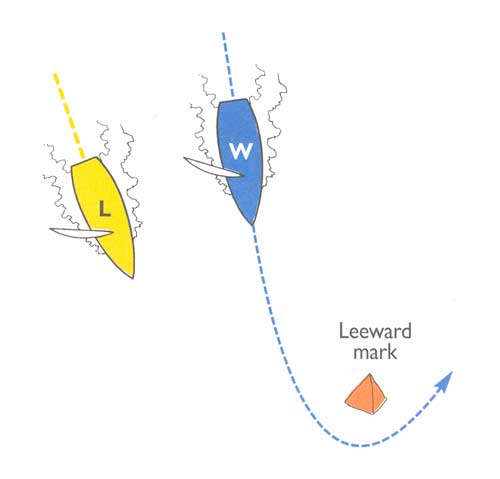 |
| These two boats on port tack are about to round a leeward mark. Rule 11 says the windward boat (W) must keep clear of the leeward boat (L). But rule 18, the ‘mark rounding’ rule, says the outside boat (L) must give room to the inside boat (W). Since these two rules are in conflict, rule 18 takes precedence because it is in Section C of the rulebook. Therefore L must give W room to round the mark. |
|
Section C - At Marks and Obstructions |
Mark roundings are probably the most critical part of any race because they
provide many chances to gain or lose. If you want to come out ahead, you need a
good working knowledge of the rules. In fact, before you even try to make
tactical moves near a mark, it’s crucial to understand your rights and
obligations under rule 18. Otherwise the two-length zone may seem more like the
twilight zone.
Most sailors know that rule 18 applies to boats in the process of rounding or
passing marks and obstructions. But when exactly does this rule turn on? And
when does it turn off?
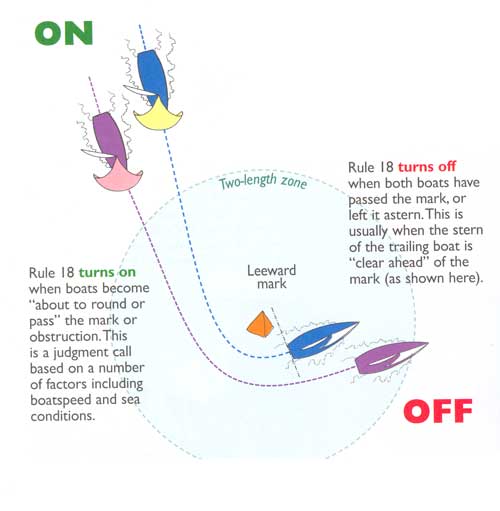 |
According to the first section of rule 18, the “buoy room” rule begins to apply
when boats are “about to round or pass” a mark or obstruction. ISAF Case 84
explains there is no exact point at which a boat becomes ‘about to round or
pass’ a mark. The decision states, “Almost always, a boat two hull lengths from
a mark is ‘about to round or pass’ it, but this is some times so at a greater
distance too. Not only is the distance from the mark a factor, but the boat’s
speed is also important, and other factors such as the conditions of wind and
current and the amount of sail handling required before or during the rounding
may also be relevant.”
To know when rule 18 applies, you have to look at the particular circumstances
of each mark-rounding situation. On a day with light air and flat water, boats
without spinnakers might not be ‘about to round’ the mark until they reach the
two-length zone. When you have fast boats with spinnakers in windy, rough
conditions, however, they might be ‘about to round’ the mark when they are four
or five lengths away (or even farther!).
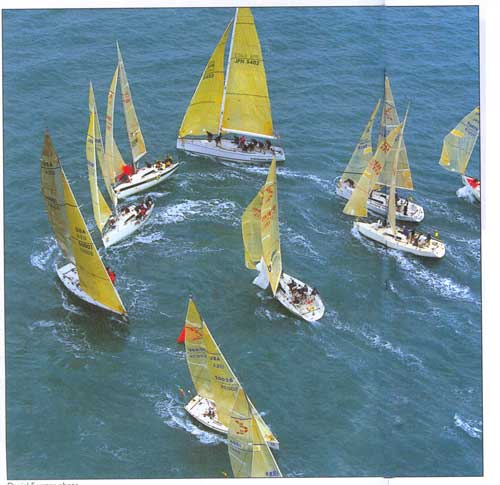 |
| A common misperception about rule 18 is that it begins to apply when boats reach the two-length zone. In most situations boats are considered to be “about to round or pass” the mark or obstruction before they reach the zone, and this is when rule 18 turns on. In this photo, many of the boats approaching the mark are still outside the zone. However, because of their size and speed, the windspeed and the amount of sailhandling required, all these boats are “about to round” the mark. Therefore, rule 18 is turned on for all of them. |
It’s apparent that rule 18 turns on at quite different times, but it always
turns off when boats have “passed” the mark or obstruction. This latter point is
not defined precisely, but common sense says a boat has passed a mark once she
has left it astern. Note that rule 18 continues to apply until both boats are
past the mark or obstruction.
As with most rules, there are a number of particular places and times when rule
18 does or doesn’t turn on. For example, it applies only when boats are passing
a mark on the same required side, or an obstruction on the same side.
There are two specific times when rule 18 never applies. The first is at a
starting mark or its anchor line, from the time boats are approaching them to
start until they have passed them. This is the familiar “anti-barging” rule.
The other time rule 18 does not apply is when boats are on opposite tacks on a
beat to windward. This is why you can’t call for room when you are approaching
the windward mark on port tack.
5 times when rule 18 does apply
 |
| 1) Rule 18 applies when boats are about to round or pass a mark or obstruction, even if they are on opposite tacks (as long as they aren’t beating and neither has to tack to round the mark). |
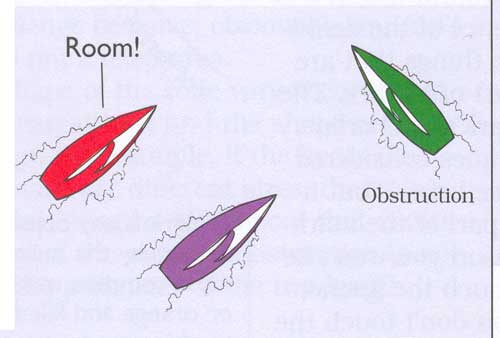 |
| 2) Rule 18 applies when two boats are passing on the same side of an obstruction. A common example of this is ducking a starboard tacker on a beat. |
 |
| 3) Another time that rule 18 applies at an obstruction is when two boats approach a clear-ahead boat, such as one that is luffing at the start. |
 |
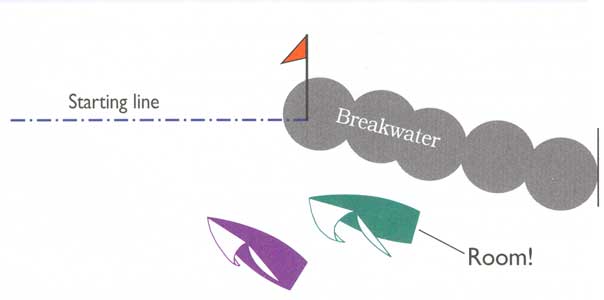 |
| 5) Rule 18 applies at a starting mark that is not surrounded by navigable water. So if one end of the line is a breakwater, an inside boat gets room. |
5 times when 18 does not apply
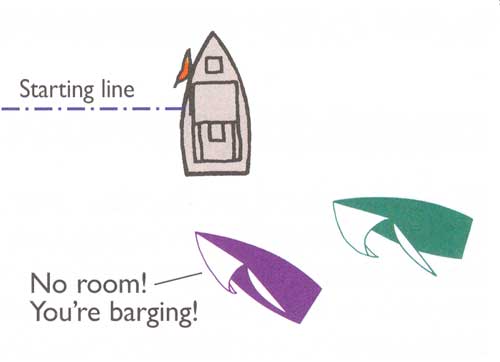 |
| 1) “Anti-barging rule” Rule 18 does not apply at a starting mark (or its anchor line) from the time boats are approaching it to start until they have passed it. |
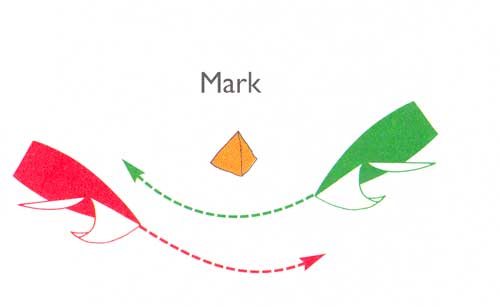 |
| 2) Rule 18 does not apply when boats are leaving a mark on different sides. Here the Green boat is leaving the mark on her starboard side while the Red boat is leaving it to port. |
 |
| 3) Rule 18 does not apply when boats are on opposite tacks on a beat to windward. |
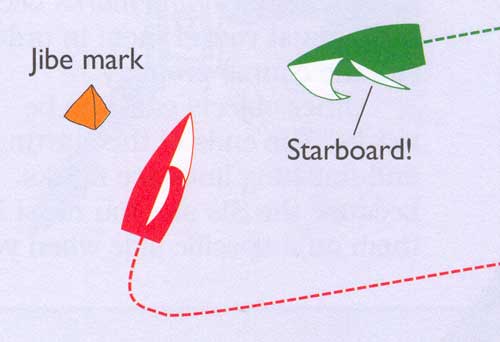 |
| 4) Rule 18 does not apply when boats are on opposite tacks and one, but not both, will have to tack to pass the mark or obstruction. |
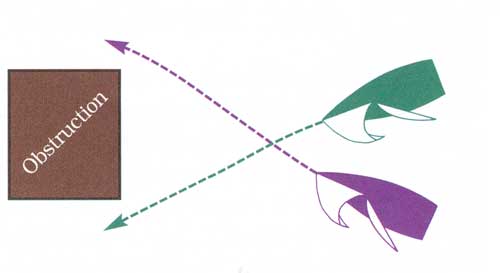 |
| 5) Rule 18 does not apply when boats are planning to pass an obstruction on different sides. |
Dave publishes the newsletter Speed & Smarts. For a subscription call:
800-356-2200 or go to:
www.speedandsmarts.com